Municipal Water Treatment – Yucaipa Valley Water District
![]()


Enhancing Water Treatment Plants with Self-Cleaning Water Filters
Abstract: This case study explores the implementation of self-cleaning water filters in water treatment plants and their impact on improving the efficiency and effectiveness of the treatment process. By adopting these innovative filtration systems, water treatment plants have been able to overcome challenges associated with conventional filter maintenance, reduce operational costs, enhance filtration performance, and ensure a consistent supply of high-quality water. This study highlights the key benefits and outcomes of utilizing self-cleaning water filters in water treatment plants.
Water treatment plants play a crucial role in providing clean and safe drinking water to communities. Traditional filtration systems used in these plants require frequent maintenance, leading to operational downtime and increased costs. Self-cleaning water filters offer a viable solution to address these challenges by automating the cleaning process, improving overall plant efficiency, and ensuring reliable water treatment operations.
Brief History of The Yucaipa Valley Water District
The Yucaipa Valley Water District originated from the merger of several mutual water companies created over one hundred years ago. These mutual water companies and other improvement districts were consolidated over time to create the Yucaipa Valley Water District which operates under the County Water District Law, Division 12, Section 30000 et. seq. of the State of California Water Code.
As a special-purpose government, or special district, the Yucaipa Valley Water District is an independent governmental unit that exists separately from general purpose governments such as county or city. Specifically, the Yucaipa Valley Water District service area includes properties in Riverside County, San Bernardino County, Yucaipa and Calimesa.[i]
[i] https://www.yvwd.us/about_us/transparency.php
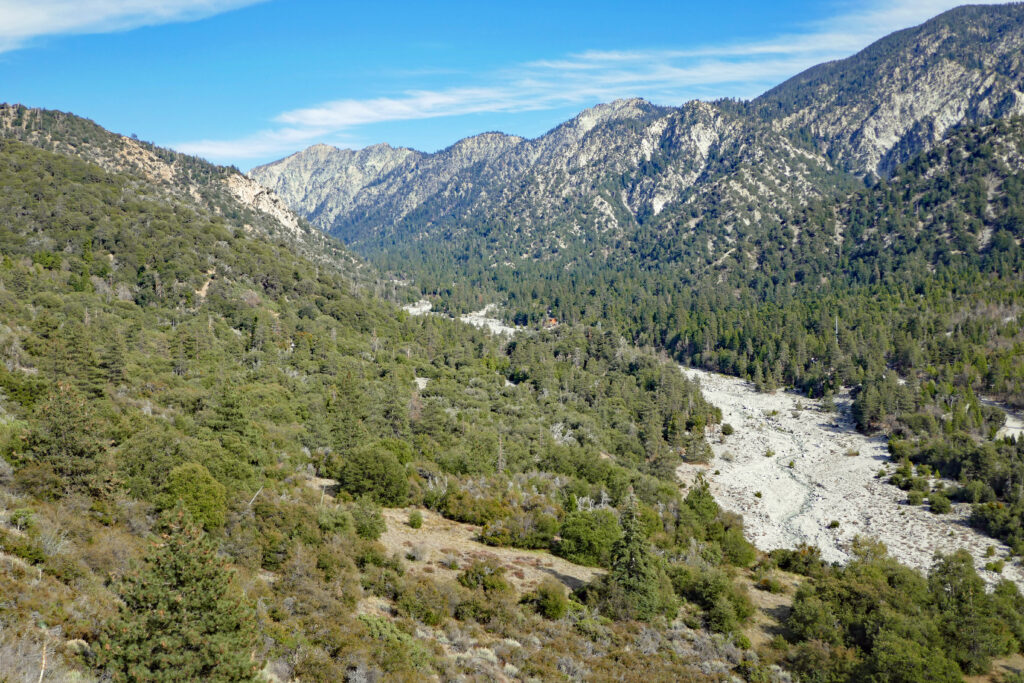
About The Yucaipa Valley Yucaipa (Serrano: Yukaipa’t) is a city located 10 miles (16 km) east of San Bernardino, in San Bernardino County, California, United States. The population was 54,542 at the 2020 census, up from 51,367 at the 2010 census.[i]
Prior to the Spanish colonization of the Americas and the arrival of European settlers from Mexico, the Yucaipa Valley was known as Yukaipa’t, which meant “green valley” in the Serrano American Language.
Native Land Acknowledgement The land was home to the Serrano Native Americans for thousands of years. The Yuhaaviatam Clan of the Maara’yam (Serrano) now known as the San Manuel Band of Mission Indians, continue the tradition of holding sacred the land and everything it provides. [ii]
[i] https://en.wikipedia.org/wiki/Yucaipa,_California
[ii] https://sanmanuel-nsn.gov/culture/history
Services Provided by The Yucaipa Valley Water District
Water Service
The District’s local water is supplied from groundwater through local wells, and surface water collected from Birch Creek, Oak Glen Creek, Adams Tunnel and Clark Tunnel. Additionally, the District purchases imported water from the State Water Project through the San Bernardino Valley Municipal Water District and the San Gorgonio Pass Water Agency for direct filtration and for recharge of the groundwater basin. The State Water comes from Silverwood, Citrus, Crafton, and then to the Yucaipa Valley Regional Water Filtration Facility.
Sewer Service
The Yucaipa Valley Water District provides sewer collection and sewer treatment services. Sewer treatment takes place at the highly advanced Wochholz Regional Water Recycling Facility that provides advanced treatment, including the capability to demineralize the recycled water. The demineralization process involves a reverse osmosis system that separates small molecules from the recycled water supply.
Recycled Water Service
The Yucaipa Valley Water District operates several recycled water facilities throughout their service area. This recycled water system provides irrigation water to parks, schools, golf courses and other landscaped areas in order to conserve drinking water supplies.
Salinity Management
In 2012, the Yucaipa Valley Water District completed an extension of the Inland Empire Brineline operated by the Santa Ana Watershed Project Authority. The brine disposal facility is critical to ensure the Yucaipa Valley Water District meets the stringent water quality objectives set by the Regional Water Quality Control Board for the Yucaipa Management Zone, Beaumont Management Zone and the San Timoteo Management Zone.
Water Filtration at The Yucaipa Water Treatment Plant
Figure 1 Schematic
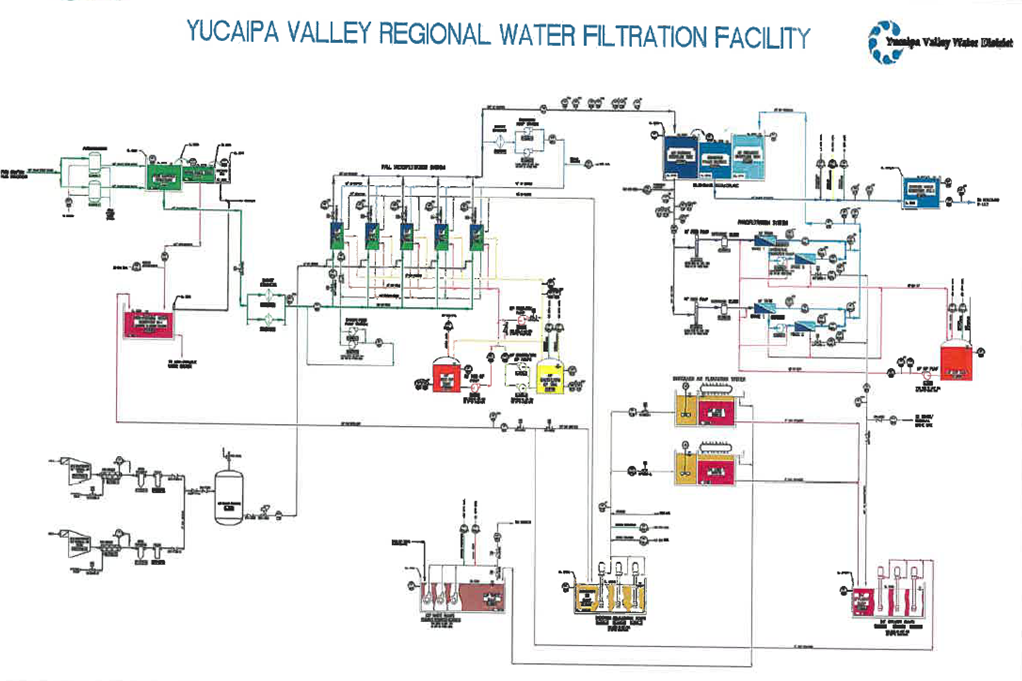
About Membrane Filtration
In its most simple terms membrane filtration involves passing a single feed flow through a membrane system that separates it into two individual streams, called the permeate and the concentrate. The membrane that separates them is a physical barrier with specialized features – a barrier that only certain selected substances in the feed stream can pass through.
There are four generally recognized types of membrane filtration. They are defined on the basis of the size of material substances they are required to separate from the feed fluid. The four types of membrane filtration are; reverse osmosis (RO), nanofiltration (NF), ultrafiltration (UF) and microfiltration(MF), in order of increasing pore size.
The Microfiltration Racks (MF) Membranes at Yucaipa
Figure 2 MF Racks
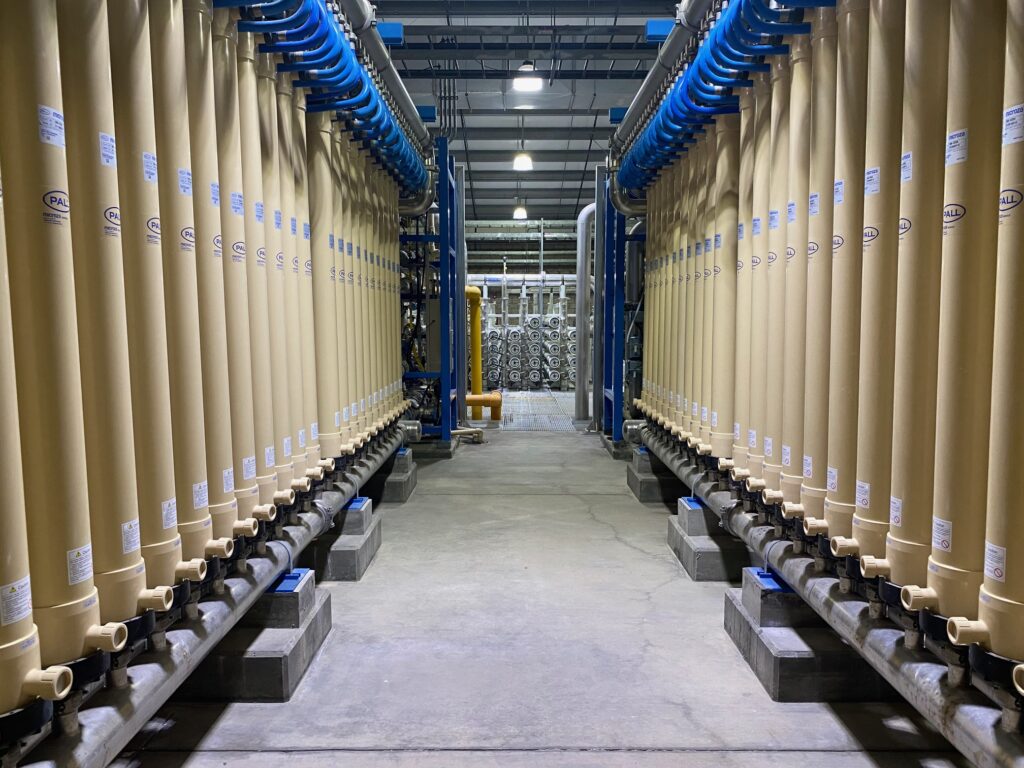
Manufacturer’s Functional Description:
The MF process uses hollow fiber membranes to filter contaminants (suspended solids and microorganisms) from the water. These fibers are contained in the membrane modules and assembled into treatment units (racks). Supporting the membrane units are a number of auxiliary support systems, including an excess feed (EF) system, reverse filtration (RF) pumps, a combined enhanced flux maintenance (EFM) /Clean In Place system, a process air (PA) system and a compressed air system.
The entire system is comprised of 5 membrane units, producing a total of 13.6 mgd of filtrate effluent at a design flux of 55 gfd.
The double block and bleed valve configuration is a critical element of the design of the MF unit, ensuring that EFM/CIP solution does not contaminate the feed or filtrate water supply.
Each unit has the following modes of operation:
Auto Mode: Automatic mode operation is the normal operating mode, in which the supervisory system PLC controls the sequencing of each rack through the different cycles. Auto Mode includes the following sequences.
- Fill
- Forward Flow (FF)
- Air Scrub (AS)
- Reverse Filtration (RF) or Feed Flush (FL)
- Enhanced Flux Maintenance (EFM)
- Integrity Test (IT)
- Clean in Place (CIP). CIP mode is a special sequence used to chemically clean the modules. The use of this sequence is infrequent; the design CIP interval is a minimum of 30 days, and is executed every nine to twelve months.
Manual Mode: In Manual Mode, the operator may cycle valves as desired, either remotely from the control room or locally from the valve rack control panel interface.
Disable Mode: When a rack is disabled, all valves will be in their normal positions and no process can be run manually or automatically. All the actuated valves are furnished with proximity-type limit switches to indicate open/closed position.
The flow rate through the membranes is variable do to the source; (Free Surface Structure) level, the Microfiltration (MF) racks current process and the MF modules organic build up due to lack of cleaning.
Membrane Protection – The Problem with Conventional Water Filtration Systems: Cartridge Filters
Conventional water filtration systems in treatment plants often face the following challenges:
- Accumulation of particulate matter and debris, leading to decreased filtration efficiency
- Frequent manual cleaning and maintenance, resulting in downtime and increased labor costs
- Inconsistent filtration performance, impacting the quality of treated water
- Potential for contamination during maintenance procedures
- Excess waste production from consumables
An Automatic Sustainable Solution – Forsta Self-Cleaning Filters
Self-Cleaning Water Filter Technology: Self-cleaning water filters utilize advanced mechanisms and automated processes to maintain optimum filtration performance. These filters are equipped with built-in cleaning mechanisms that remove accumulated solids from the filtration media without the need for manual intervention. The self-cleaning process ensures continuous filtration, minimal downtime, and improved operational efficiency.
Self-cleaning filters consistently deliver high-quality water by maintaining a low-pressure drop across the media. The removal of debris and particulate matter on a set interval prevents clogging and enables efficient filtration; ensuring consistent water quality standards are met.
Reduced Maintenance Downtime: By automating the cleaning process, self-cleaning filters significantly reduce the frequency and duration of maintenance activities. This minimizes downtime, allowing treatment plants to maintain continuous operation and meet water supply demands.
Cost Savings: The automated cleaning process eliminates the need for manual labor and associated maintenance costs. Moreover, the extended lifespan of the filter media reduces the frequency of media replacement, resulting in substantial cost savings over the long term.
Improved Operational Efficiency: Self-cleaning filters optimize the use of resources by reducing backwashing frequency and water consumption. The precise control and monitoring capabilities of these filters enable operators to fine-tune the cleaning cycles, maximizing operational efficiency and minimizing wastage.
Easy Integration and Compatibility: Self-cleaning filters can be easily integrated into existing water treatment plant infrastructure without significant modifications. They are compatible with various treatment processes, such as sedimentation, coagulation, and disinfection, making them adaptable to diverse plant configurations
Figure 3 A Forsta self-cleaning strainer protects all membrane technologies by reducing particle loading in the feed stream.
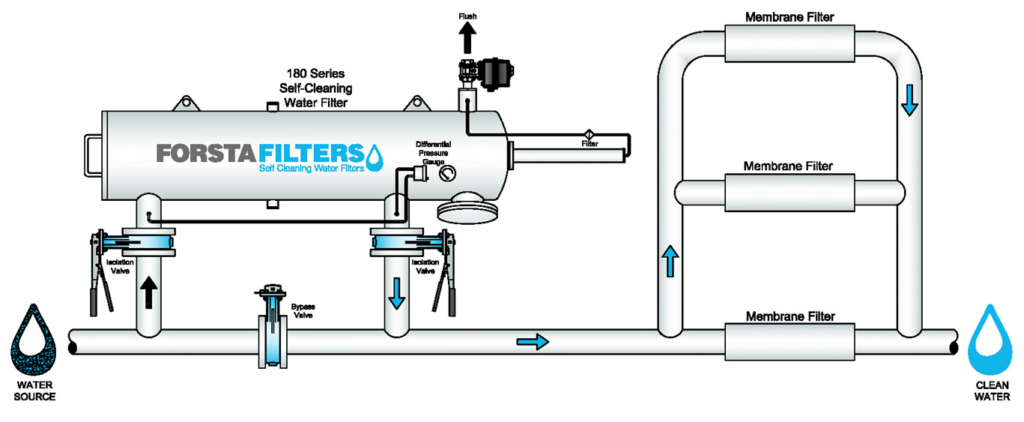
Making The Change at Yucaipa
Based on influent turbidity issues, and the inefficiency of 12yr. old brass strainer baskets, in 2019, The Yucaipa Valley Water District elected to replace the old baskets with new self-cleaning screen filters to decrease staff labor and increase efficiency.
Operations manager Mike Kostelecky explained that “The installation of the Forsta Self-Cleaning Filters has been a game changer with minimal effort or concern. They do the work as prescribed and we do other tasks. With the old brass baskets installed, operator life consisted of a manual wash with a differential pressure of five. This was anytime, over and over. A manual wash consisted of manually closing two valves for each strainer. To complete a manual wash on each strainer was 15 minutes, and we would ensure both were cleaned. I would estimate in a normal day, under normal flows and weather, one hour/day of operator labor was in-efficiently used.
I’ve personally washed the old baskets 10 times in a day! And twice we have encountered an algal bloom where in 10 hours it was difficult to staff the constant cleanings.”
Figure 3.5 Old Basket Strainers
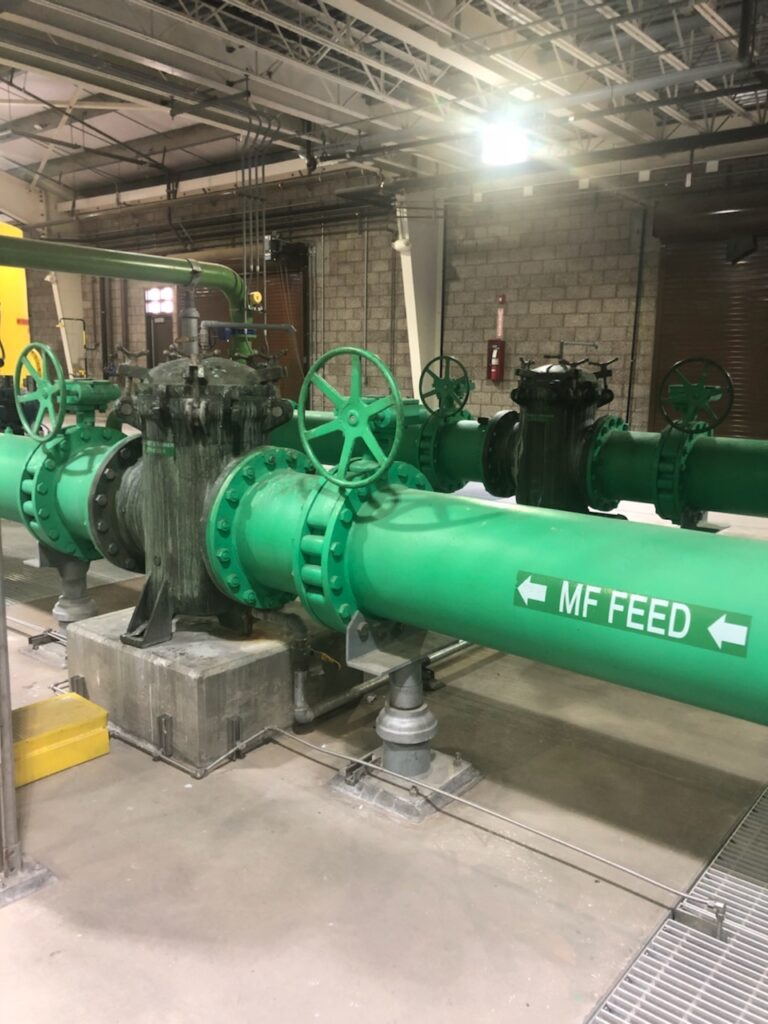
Over time:
- Both internal baskets were replaced at a cost of 11K
- The isolation valves were all failing because of the over-use and needed replacement. This was estimated at approximately $20K for the four valves.
Forsta Self-Cleaning Filters at The Yucaipa Water Treatment Plant
Figure 4 Forsta H18-LP180 Filters at Yucaipa Water Treatment Plant
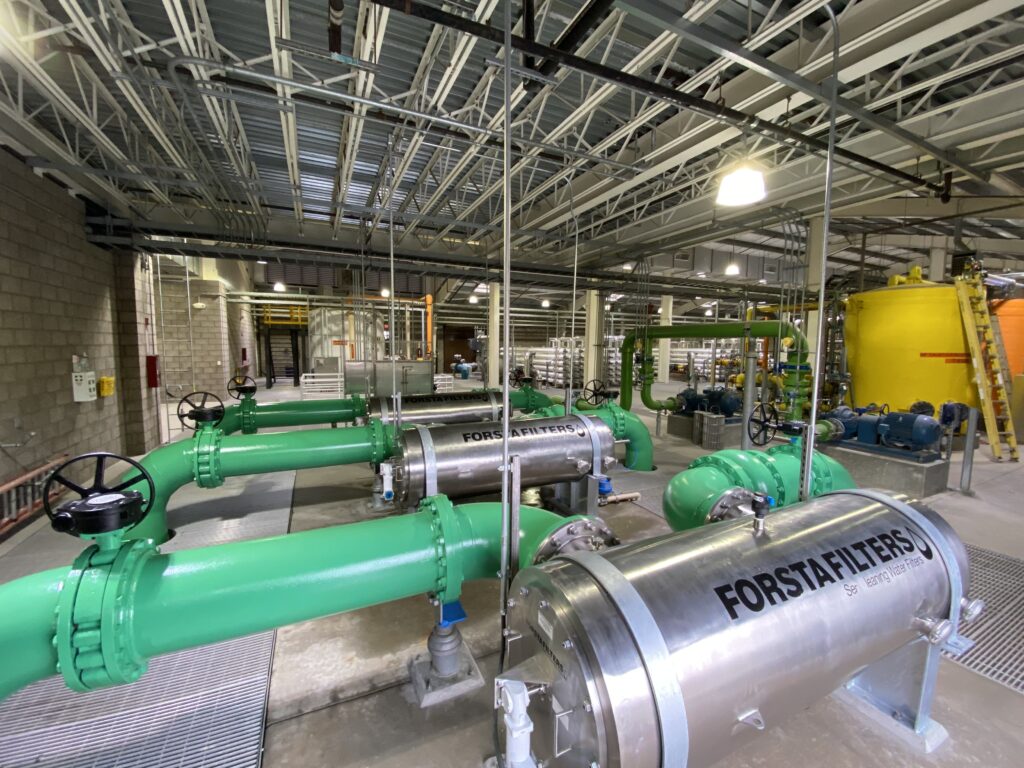
LP180 Series Self-Cleaning Filters
(3) H18-LP180 model filters with 300 micron screens. 24.5 sq ft. of screen area each.
Max flow per filter of 6125gpm. Filters are installed upstream of MF membranes. The electric motor-driven design allows for efficient operation at 30psi of system operating pressure
Filter Performance – Backwash Data
Backwash frequency of the self-cleaning filters depends on the day. Factors such as seasonal weather and temperature affect the influent turbidity and solids loading. In a typical 24-hour day, the self-cleaning filter equipment at Yucaipa runs four backwashes initiated based on timer or one backwash every 6 hours. When influent quality is at is baseline, the differential pressure set point is not reached before the timed backwash is triggered.
Flow, turbidity, inlet/outlet and differential pressure readings are logged every 5 minutes, and the trend is checked continuously via SCADA and monitored with alarm set points.
Shown in Figure 5, are six typical days of differential pressure readings in May of 2022. The graphs demonstrate that differential pressure due to accumulated debris on the filter screens ranged from 0.5 psi to 4psi over a six-day period. The backwashes initiated on the timed interval ensure that debris is consistently removed from the screen, even when differential pressure is not reached.
Figure 5 DP Readings May 4 – May 9 2022
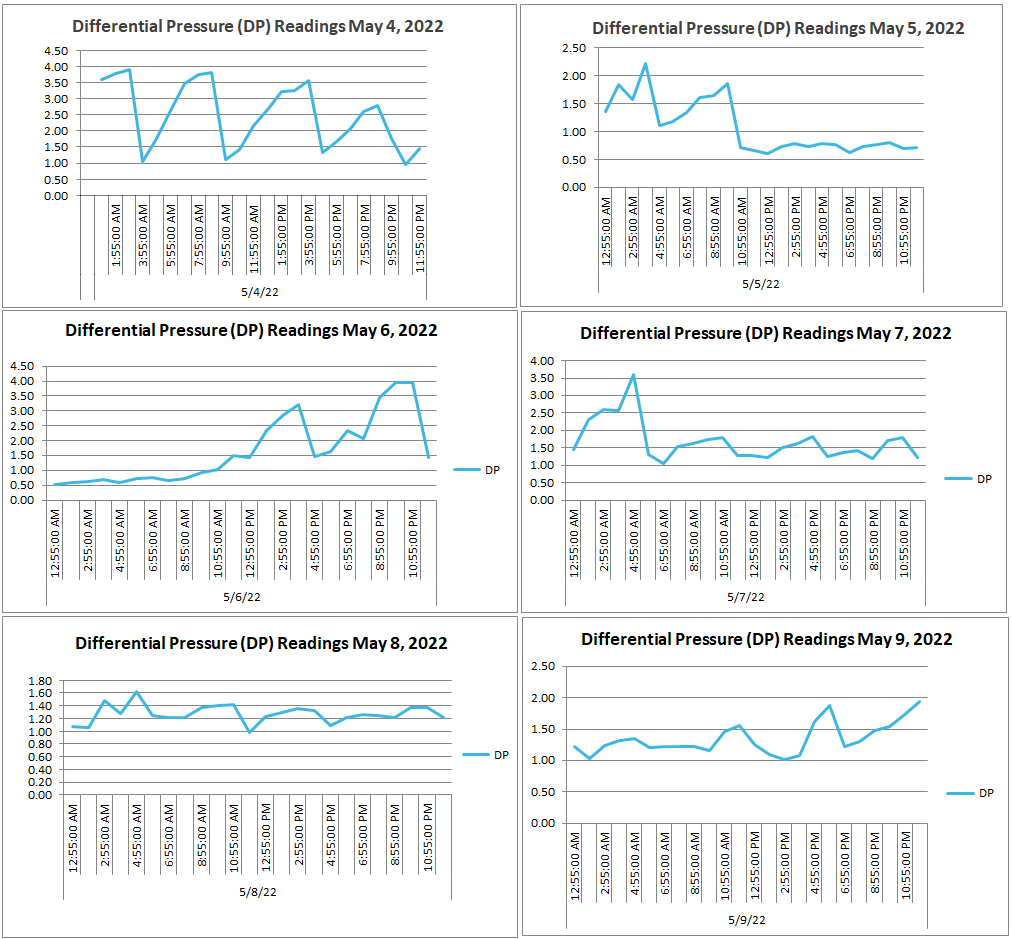
Increases in influent solids loading result in higher frequency backwashes during the upset conditions. Figure 6 below shows July 6, 2022 when the filter backwashed a total of 9 times in a 12 hour period, as compared to the typical 2 backwashes in a 12 hour period.
Whether during typical conditions or upset conditions backwash volume is less than 1% of total flow.
Figure 6 DP Readings July 6, 2022
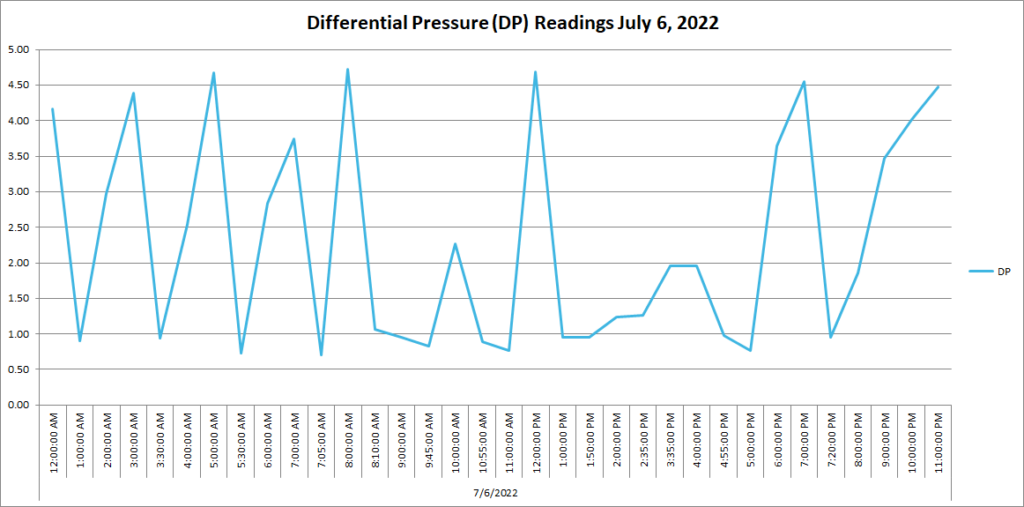
Conclusion
The case study of The Yucaipa Valley Water District shows how the implementation of self-cleaning water filters improved the efficiency and effectiveness of the treatment process. By adopting a self-cleaning filter system, Yucaipa was able to overcome the challenges associated with conventional filter maintenance, reduce operational costs, enhance filtration performance, and ensure a consistent supply of high-quality water.
Mike Kostelecky said of the Forsta self-cleaning filters, “they continue to perform beyond excellent and have recently endured the highest turbidity we have seen through this plant since 2007 start up. The influent was as high as 18 ntu and noticeably dirty. The reason for the turbidity was a result of an algal bloom at Citrus Reservoir. Nonetheless, the Forsta Filters handled the uprise without issues, and we are back to normal business.”
About the Author:
Polly Stenberg is Director of Sales with Forsta Filters Inc. – A California-based original equipment manufacturer. Stenberg has conducted case study reviews with customers using Forsta self-cleaning filters in drinking water, wastewater, cooling, agricultural/landscape irrigation and industrial process systems.
View this study as a pdf:
Case Study_Yucaipa Valley Water District_Water Treatment Plant